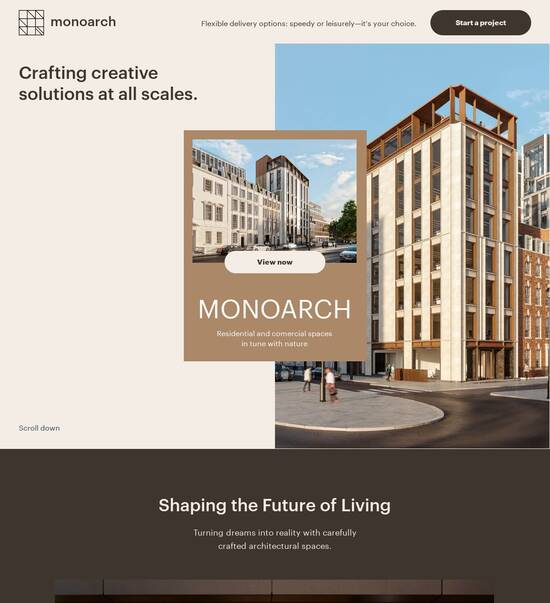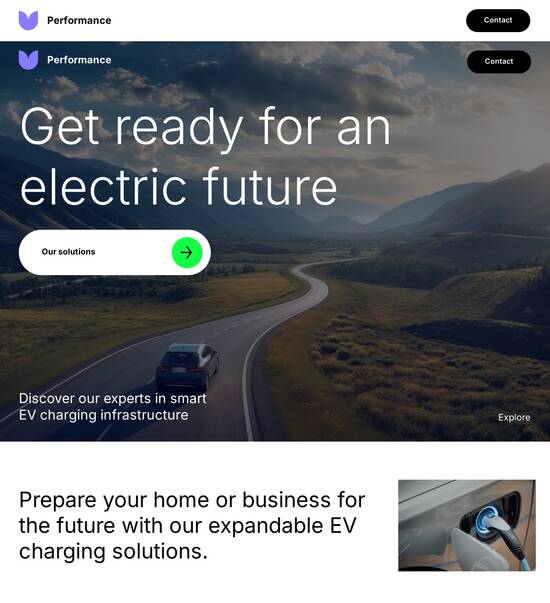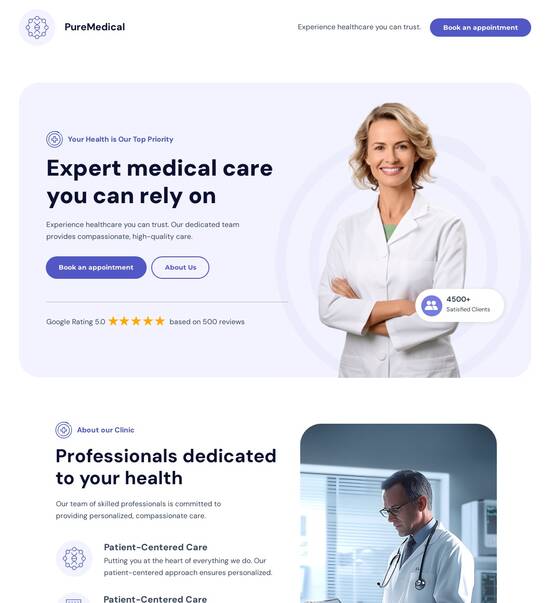
HTML/CSS optimized personal information page template
Explore Similar TemplatesAbout template
Supercharge your personal information page with HTML/CSS for outstanding performance! Learn more today.
Recommended templates

Easy to build without coding
With the intuitive drag-and-drop builder, anyone on your team can create high-converting pages without any knowledge of code or design. Make enhancements to your landing page with custom widgets using Javascript, HTML/CSS, or third-party scripts.

Multiple layouts for any industry and goal
Select from 500+ landing page layouts built to boost conversions across industry-specific scenarios. Customize them by adjusting fonts, adding images, and generating on-brand content with the AI assistant. Quickly scale with Instablocks® and Global Blocks that you can save, reuse, and update globally.

Loads fast and looks polished on any device
Every template is responsive, which means they present professionally on any device and load blazingly fast with our Thor Render Engine. You can also power them up with Google AMP technology to deliver an unparalleled mobile experience and drive higher conversions.

Robust analytics & experimentation
Get real-time updates and reporting across all your devices, showing the number of visitors, conversions, cost-per-visitor, and cost-per-lead. Launch AI-powered experiments, run A/B tests, and use heatmaps to analyze user behavior, then optimize your landing page to maximize conversions.







Easy to build without coding
With the intuitive drag-and-drop builder, anyone on your team can create high-converting pages without any knowledge of code or design. Make enhancements to your landing page with custom widgets using Javascript, HTML/CSS, or third-party scripts.
Multiple layouts for any industry and goal
Select from 500+ landing page layouts built to boost conversions across industry-specific scenarios. Customize them by adjusting fonts, adding images, and generating on-brand content with the AI assistant. Quickly scale with Instablocks® and Global Blocks that you can save, reuse, and update globally.
Loads fast and looks polished on any device
Every template is responsive, which means they present professionally on any device and load blazingly fast with our Thor Render Engine.
Robust analytics & experimentation
Get real-time updates and reporting across all your devices, showing the number of visitors, conversions, cost-per-visitor, and cost-per-lead. Launch AI-powered experiments, run A/B tests, and use heatmaps to analyze user behavior, then optimize your landing page to maximize conversions.
All the features you need to build html code to display personal information
Explore more featuresLearn how to build how to create a website theme
Frequently asked questions about personal information html code
Leading the way in building high-performing landing pages





Profile page: Your ultimate how-to guide
Effective landing page optimization can significantly elevate your marketing efforts. Instapage offers a suite of powerful tools designed to enhance conversion rates across different verticals, making it the choice platform for marketers in the USA. Whether you're in business services, tech or financial sectors, Instapage provides the resources to maximize ROI through expertly crafted landing pages.
Understanding the importance of landing page optimization
Landing page optimization involves tailoring web pages to convert visitors into leads or customers. With Instapage, you can create high-performing landing pages that are visually appealing and conversion-focused. Here are a few reasons why landing page optimization is crucial:
- Enhanced user experience: A well-structured landing page guides users seamlessly toward their goals, increasing the likelihood of conversion.
- Improved ad relevance: High-quality landing pages boost ad quality scores, reducing costs and improving placement in search results.
- Data-driven insights: Utilizing detailed analytics and heatmaps helps refine your landing page design based on user behavior.
Step 1: Selecting the right templates for your audience
Choosing the right template is fundamental to the success of your landing page. Instapage provides over 100 customizable templates tailored to your audience's needs. Consider the following when selecting a template:
- Industry customization: Different verticals benefit from tailored designs. Choose a template that aligns with your industry aesthetics.
- Responsive design: Ensure that the template is mobile-friendly to cater to all users as mobile traffic is increasingly dominant.
- Conversion-focused: Opt for templates designed with proven conversion techniques in mind, maximizing effectiveness.
Step 2: Personalizing page experiences
Personalization can dramatically increase engagement and conversion. Utilizing dynamic text replacement and personalized content allows you to target specific segments. Here’s how to effectively personalize your landing page:
- Audience segmentation: Tailor content according to distinct audience segments, incorporating relevant images and messaging.
- Leveraging data: Use data tools to analyze visitor behavior and adjust the landing page content dynamically in real-time.
- Integration of ads: Use AdMaps to connect specific ads to their appropriate landing pages, ensuring consistency in messaging.
Step 3: Continuous optimization and testing
Optimizing your landing pages is an ongoing endeavor. With Instapage's built-in experimentation features, you can easily conduct A/B tests and analyze performance.
- A/B testing: Regularly test different elements such as copy or images to determine what resonates best with your audience.
- Analytics tracking: Utilize the analytics dashboard to monitor key performance indicators and adapt strategies based on performance data.
- Feedback loops: Gather insights from team collaboration on key changes to refine your approach based on collective feedback.
In summary, mastering landing page optimization through Instapage can significantly enhance your digital marketing efforts. With tools designed for efficiency and collaboration, you’re well-equipped to maximize your campaign ROI.
Get started with Instapage today to revolutionize your landing page efforts! Sign up now and access powerful tools that will transform your marketing campaigns into success stories.
HTML/CSS optimized personal information page template
Understanding the importance of an optimized personal information page template
Personal information pages serve as an online representation of individuals or businesses. They communicate essential information such as your background, services, and contact details. The primary purpose of these pages is to establish an online presence that is informative and user-friendly, thereby enabling visitors to quickly understand your offerings.
Optimization is vital in enhancing user experience; it ensures your page loads quickly and is easy to navigate. If a page fails to meet users' expectations, it may lead to decreased engagement and higher bounce rates. Fortunately, an optimized personal information page can mitigate these issues by providing a seamless experience that retains visitors.
Engagement metrics can be impacted positively through optimizations, leading to longer visit durations.
An optimized page is better suited for search engines, improving visibility.
Your target audience consists of various groups ranging from beginners who need a straightforward template to professionals who require more advanced features. Understanding what each group seeks allows you to tailor your content and structure appropriately.
Core components of an HTML/CSS optimized personal information page template
The structure and layout of your personal information page play a crucial role in delivering information effectively. Start with a well-designed header that includes a logo and a navigation menu. This sets the tone for usability and guides visitors throughout the page. Next, the main content area should cover your 'About' section, services offered, and any product listings.
Additionally, including a sidebar that displays contact information and social links can enhance engagement and facilitate quick access to additional content. Finally, consider a footer with copyright information and additional links for user convenience. This complete structure ensures that all crucial elements are accounted for.
Header: Logo and Navigation Menu
Main Content Area: About Section, Services, and Products
Sidebar: Contact Information and Social Links
Footer: Copyright and Additional Links
CSS styling techniques are essential to make your personal information page visually appealing. Responsive design ensures that your template is accessible on various devices, thus enhancing overall user experience. Opt for color schemes and typography that improve readability, making the content easy to digest for users.
Incorporating accessibility features such as high text contrast and alternative text for images is imperative. This enhances usability for individuals with disabilities and ensures everyone can engage with your content. Additionally, consider keyboard navigation for enhanced accessibility.
Unique features and functionalities
To stand out, your personal information page should integrate unique functional features like dynamic content integration. Embedding various media types, such as images, videos, and interactive maps, enriches the user experience. Real-time updates on services and products play a crucial role in keeping your content current.
Interactive elements, such as forms aimed at customer engagement, can encourage visitors to provide feedback or inquiries. Establishing test functions for user feedback is equally important; it allows you to gauge user sentiment directly, making improvements based on real data.
Forms for Customer Engagement
Test Functions for Collecting User Feedback
User-centric design features, like testimonials and reviews sections, foster trust and credibility. Additionally, including a FAQ section can provide immediate assistance, addressing common questions and improving the overall user journey on your page.
The role of HTML and CSS in creating an engaging experience
HTML serves as the backbone of your personal information page template. By utilizing semantic tags and structural elements, you can enhance accessibility and clarity, making it simpler for search engines to index your content. A clean codebase promotes future scalability and easier updates.
CSS, on the other hand, elevates the aesthetics and usability of your page. Advanced styling techniques enable the creation of visually appealing interfaces. Utilizing animations and transition effects adds delight to user interactions, making the browsing experience enjoyable.
Advanced Styling Techniques
Animation and Transition Effects for User Delight
It is essential to optimize load speed by adhering to HTML and CSS best practices. This guarantees that users experience minimal delays, thereby improving engagement statistics and overall satisfaction.
Step-by-step setup guide for your personal information page template
Before diving into coding, preparing your environment is critical. Determine which software and tools you need, such as code editors and graphic design software. Decide whether to develop locally or use an online environment that can streamline your process.
Coding your template requires understanding basic HTML structure. Begin with the foundational tags and create sections for navigation, content, and footer areas. Once your HTML framework is established, you can add CSS styling. From external stylesheets to inline styles, explore various methods to implement design components that align with your vision.
Software and Tools Required
Local vs. Online Development Environments
Testing and troubleshooting should not be overlooked. Familiarize yourself with common issues and their fixes, whether they be browser compatibility hiccups or CSS styling errors. Utilize available tools that measure website performance and compatibility, which can help fine-tune user experience.
Enhancing skills through practical exercises and tutorials
To enhance your skill set, engaging in hands-on modifications is beneficial. Tweak layouts and styles according to your preferences, or incorporate JavaScript to introduce interactivity. These small projects can vastly improve your understanding of HTML, CSS, and web development.
Exploring a variety of learning resources can assist in continuous skill development. Consider online tutorials and courses that provide comprehensive insights into HTML and CSS. Additionally, community forums often feature groups that focus on coding support, fostering an environment for collaboration.
Customizing Layout and Styles
Incorporating JavaScript for Interactivity
Adopting a project-based learning approach, like creating different variants of the template, is advantageous. Tailor the design for various industries, ensuring the template meets specific needs whether for freelancers or small businesses.
Evaluating the success of your personal information page
Evaluating the success of your personal information page is essential for enhancing effectiveness over time. Key performance indicators, such as traffic analysis for user engagement, provide insights into how well your content performs. Tracking conversion rates helps you understand user actions, enabling data-driven decisions to improve effectiveness.
Implementing continuous improvement strategies, like A/B testing different layouts, can help refine user experience. Gathering user feedback through integrated forms aids in understanding visitors’ needs, thus driving further enhancements.
Traffic Analysis for User Engagement
Conversion Rate Tracking: Understanding User Actions
Staying current with trends in HTML and CSS developments is vital for long-term success. Subscribing to newsletters and updates, as well as participating in webinars and workshops, can keep you informed and ready to adapt your template as necessary.
Common questions and answers regarding personal information page optimization
When considering what makes a personal information page effective, key elements include clarity, ease of navigation, and engaging content. It’s crucial to ensure your template is mobile-responsive, which significantly enhances the user experience on various devices. Features like contact forms and clear service listings should be prioritized for optimal user engagement.
Regularly revisiting and updating content is vital for maintaining relevance. Aim to refresh your personal information page's content at least once every few months, or whenever new offerings or announcements arise. Testing tools can assist in evaluating page performance, while monitoring site traffic can provide insights into user behavior and preferences.
What makes a personal information page effective?
How can I ensure my template is mobile-responsive?
Which elements should be prioritized for user engagement?
How often should I update my personal information page content?
What tools can assist in testing the performance of my page?
Summary of key takeaways for developing an optimized template
In summary, the essential features of an optimized personal information page template focus on an engaging user experience through thoughtful design. Prioritizing SEO best practices can significantly enhance visibility, making it more accessible to your target audience.
Acknowledging that the journey of developing your skills is continual is crucial. Growth occurs through practice and adaptation over time; recent trends may shift, requiring an agile mindset and readiness to embrace new methodologies in web design.
Engaging user experience through thoughtful design
Enhanced visibility with SEO best practices
Ready to skyrocket conversions?
Supercharge your ad campaigns with high-performing landing pages
Get started














